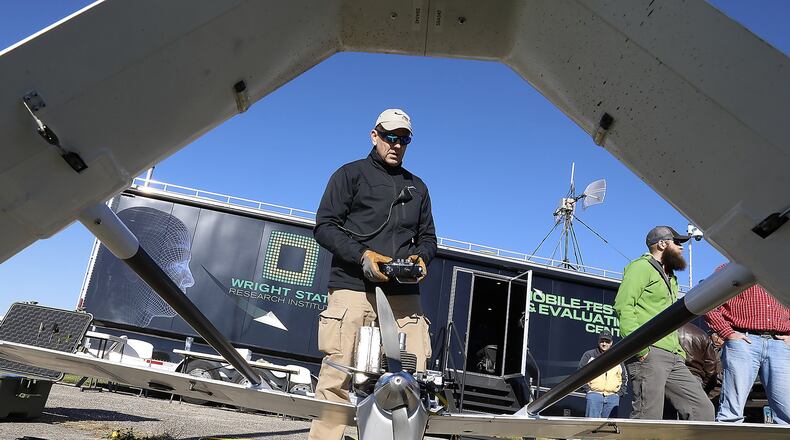RELATED STORY: New Springfield commander to prep base for new drone mission
The new technology could lead to changes in national security and defense operations on top of commercial enterprises using unmanned aerial vehicles, commonly called drones, to deliver goods to people’s doorsteps.
The aircraft don’t have a human pilot on board — instead it’s controlled from an operator on the ground who’s currently required to keep the vehicles within sight.
The Air Force Research Laboratory in conjunction with the Wright State Research Institute will install the new technology at the Springfield airport before the end of the year, said Art Huber, director of operations at the AFRL.
“This will be ground breaking,” he said.
If the Federal Aviation Administration approves, the Springfield airport testing grounds would be the first site in the country to fly the aircraft beyond’s the pilot sight in the national airspace, Huber said.
READ MORE: Amazon growth helps area air park grow business
AFRL and the state of Ohio each plan to invest $2.5 million into the project to test unmanned aircraft beyond the limits they have ever been allowed under federal law.
The city of Springfield business and economic development office has been attending drone trade shows for several years, Airport Manager Don Smith said, marketing the airport for these kinds of endeavors.
The federal and state governments chose Springfield for this new test site, Huber said, because of its prime location to Wright-Patterson Air Force Base.
Before the teams traveled as far as Indiana for flying space like Springfield has, David Gross, chief engineer at the Wright State Research Institute said.
The multimillion-dollar investment will be used in conjunction with the FAA’s air traffic control network, radar and instruments already at the airport to enable a ground-based sense-and-avoid system, which allows operators to provide safe separation between drones and other aircraft flying, Gross said.
That step in drone operation could then lead to more automated flight, where the unmanned aircraft could detect obstacles, like traditional airplanes, and avoid them during travel on their own.
The Ohio/Indiana UAS Test Center in Springfield will operate the equipment.
The engineers are also working with automation, where software would be used to let the drones power themselves, Gross said, instead of a pilot making commands behind a computer.
“The aircraft is making its own decisions based on the mission objectives that you give it,” he said.
The researchers called this opportunity to get the FAA approval for new drone technology “outstanding” and that it could change the face of the use of the small aircraft in everyday life.
Federal regulators have yet to establish clear-cut rules around commercial drone use.
But online retailers like Amazon have already announced plans deliver packages via drones through its Amazon Prime Air service.
Commercially Springfield will try to get a leg up as the “first in the market” with the new testing grounds, Huber said.
“Less incentive for people to go elsewhere,” he said.
Manufacturers and retailers like Amazon could look to build around the airport, Simon said, to not only produce drones but to test them right on site.
“That would be significant for the city, for the airport and for the region,” he said.
Air Atlas Worldwide, a company with ties to Amazon, recently signed a seven-year deal with the Wilmington Air Park in Clinton County to fly 20 planes for the online store.
In-depth coverage
The Springfield News-Sun provides unmatched coverage of the impact of the drone industry in Clark and Champaign counties, including stories digging into the industry’s impact on possible job growth locally.
By the numbers
$5 million — Total investment by Air Force Research Lab and state of Ohio
$2.5 million — Amount contributed by each state of Ohio and the Air Force Research Laboratories
2017 — Year AFRL expects to begin out-of-sight test flights
About the Author
